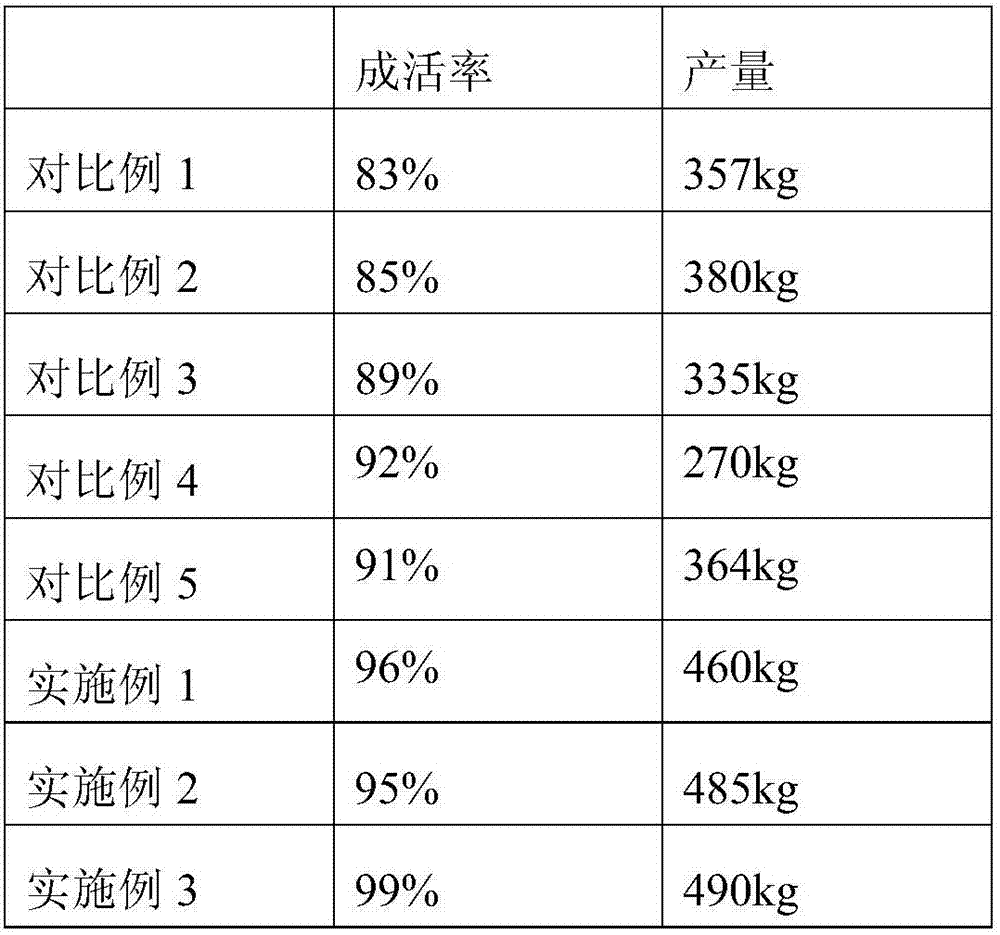Farming method of feeding snail with papaya
A breeding method and snail technology, applied in fish farming, climate change adaptation, animal feed, etc., can solve the problems of secondary damage to water quality in terraced fields, difficult to decompose, etc., and achieve the effects of promoting production, promoting growth, and increasing dissolved oxygen content
- Summary
- Abstract
- Description
- Claims
- Application Information
AI Technical Summary
Problems solved by technology
Method used
Image
Examples
Embodiment 1
[0047] 1. Preliminary preparation:
[0048] Preparation of Oxygenating Agent: In parts by weight, dissolve 3 parts of urea peroxide in 100 parts of water, stir evenly, then add 25 parts of sodium alginate, at a temperature of 55°C and a stirring speed of 150r / min Stir the reaction for 10 minutes, then add dropwise to 200 parts of saturated calcium hydroxide solution at a temperature of 5°C at a speed of 3 mL / min, stir at a speed of 100 r / min for 30 minutes, filter, and freeze-dry the filter residue at minus 17°C for 24 hours , to obtain oxygenates.
[0049] Feed preparation: by weight, 15 parts of rice bran, 10 parts of wheat flour, 6 parts of potato powder, 15 parts of Chinese yam powder, 6 parts of mung bean powder, 5 parts of sweet potato powder, 8 parts of mulberry leaf powder, 3 parts of mushroom tail , 3 parts of honeysuckle, 1 part of cellulase, 1 part of papain and 50 parts of deionized water are mixed, and the enzymolysis is carried out at a pH value of 7 and a tempe...
Embodiment 2
[0057] 1. Preliminary preparation:
[0058] Preparation of Oxygenating Agent: Dissolve 3.5 parts of urea peroxide in 110 parts of water in parts by weight. After stirring evenly, add 30 parts of sodium alginate. Stir the reaction for 11 minutes, then add dropwise at 3.5mL / min to 200 parts of saturated calcium hydroxide solution at a temperature of 5.5°C, stir at a speed of 130r / min for 40min, filter, and freeze-dry the filter residue at minus 17°C After 30h, the oxygenate was obtained.
[0059] Feed preparation: by weight, 22 parts of rice bran, 13 parts of wheat flour, 7 parts of potato powder, 18 parts of Chinese yam powder, 7 parts of mung bean powder, 6 parts of sweet potato powder, 9 parts of mulberry leaf powder, 3 parts of mushroom tail , 3 parts of honeysuckle, 1 part of cellulase, 1 part of papain and 55 parts of deionized water are mixed, and the enzymolysis is carried out at a pH value of 7.2 and a temperature of 58 °C for 4.5 hours, and then granulated in a granul...
Embodiment 3
[0067] 1. Preliminary preparation:
[0068] Preparation of Oxygenating Agent: Dissolve 3.5 parts of urea peroxide in 140 parts of water in parts by weight. After stirring evenly, add 33 parts of sodium alginate. Stir the reaction for 12min, then add dropwise at 4mL / min to 200 parts of saturated calcium hydroxide solution at 6°C, stir at 135r / min for 42min, filter, and freeze-dry the filter residue at minus 17°C for 38h , to obtain oxygenates.
[0069] Feed preparation: by weight, 17 parts of rice bran, 16 parts of wheat flour, 8 parts of potato powder, 20 parts of Chinese yam powder, 7 parts of mung bean powder, 6 parts of sweet potato powder, 9 parts of mulberry leaf powder, 3 parts of fungus mushroom , 3 parts of honeysuckle, 1 part of cellulase, 1 part of papain and 62 parts of deionized water are mixed, and the enzymolysis is carried out at a pH value of 7.7 and a temperature of 60 ° C for 5 hours, and then granulated in a granulator , and finally dried at 54° C. for 11 ...
PUM
 Login to View More
Login to View More Abstract
Description
Claims
Application Information
 Login to View More
Login to View More - R&D
- Intellectual Property
- Life Sciences
- Materials
- Tech Scout
- Unparalleled Data Quality
- Higher Quality Content
- 60% Fewer Hallucinations
Browse by: Latest US Patents, China's latest patents, Technical Efficacy Thesaurus, Application Domain, Technology Topic, Popular Technical Reports.
© 2025 PatSnap. All rights reserved.Legal|Privacy policy|Modern Slavery Act Transparency Statement|Sitemap|About US| Contact US: help@patsnap.com


